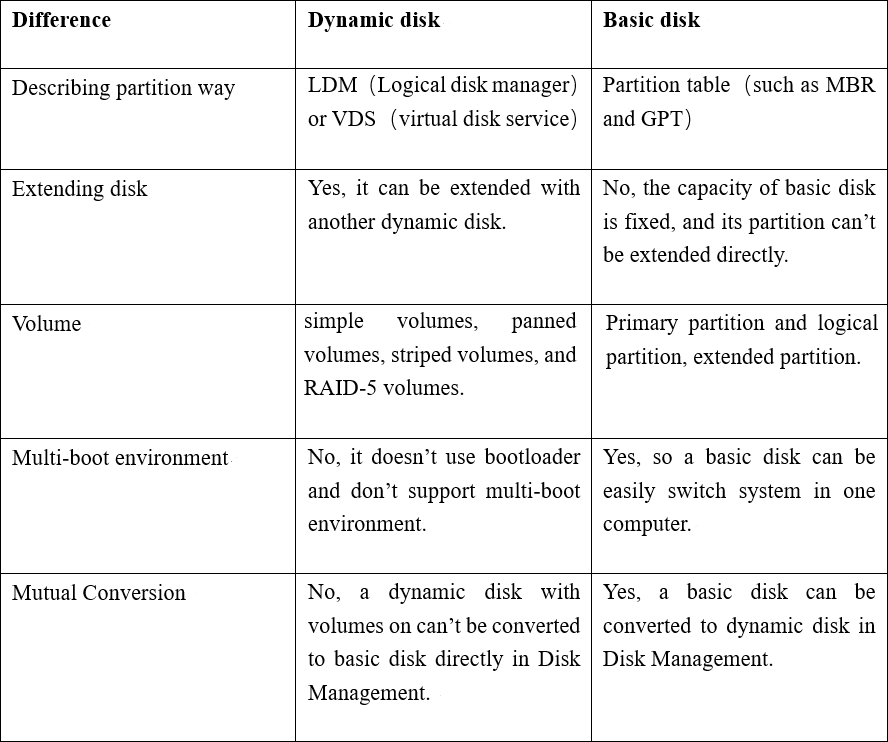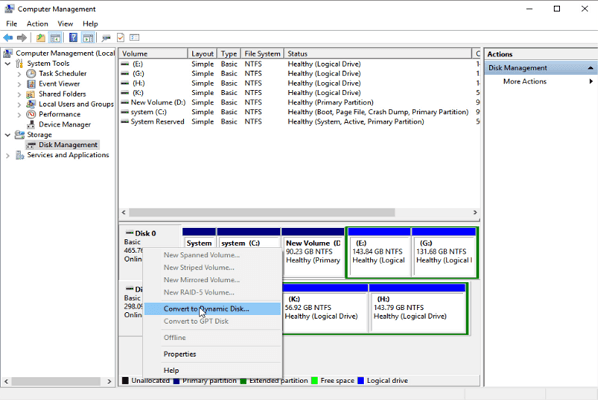Dynamic Disk vs. Basic Disk: What's the Difference and How to Convert
This post will give you an introduction of dynamic disk and basic disk, and tells you the difference between them. And teach you how to convert dynamic disk to basic disk and basic to dynamic disk.
What is dynamic disk?
Dynamic Disk is one of hard drive configurations that is most commonly used in Windows systems. You can convert a basic disk to dynamic disk. On a basic disk, the storage space will be divided into one or multiple partitions to keep data, while a dynamic disk sets several segments called "volume" to store data. And it keeps track of all volumes by logical disk manager (LDM), instead of partition tables.
Data on different dynamic disk can be related. When you change a dynamic disk, information will be recorded in the logical disk manager, which is hidden at the end of the dynamic disk. You can create and delete primary and extended partitions on the base disk, format partitions, and mark them as active.
What Is Basic Disk
A basic disk is a kind of physical disk, which can be visited by all Windows systems and MS-DOS. It is the most common disk type used in Windows OS. When you initialize a hard disk on your computer, it would initially set up as a basic disk.
Basic disks use two partition styles, MBR and GPT, where MBR can contain up to four primary partitions, or three primary partitions and one extended partition with multiple logical drives.GPT allows you to create up to 128 primary partitions. Each partition is independent.
After you understand the meaning of basic disk and dynamic disk, you can convert the disk form through AOMEI Partition Assistant without any risk of data loss. If you want to know more about the difference between basic and dynamic disks, keep reading and we will provide you with a more detailed comparison.
Dynamic disk VS basic disk: What Are the Differences
A basic disk will be initialized as MBR and GPT partition styles that decide how the disk descibe partitions on it. Like Windows 11, this system only supports UEFI boot, which means users could only use a GPT disk. A basic disk stores data on different basic partitions, or drives. You are allowed to manage storage space by resizing, deleting, extending, and formatting partitions within one basic disk.
Meanwhile, a dynamic disk also allows you to resize its volumes. Besides, you can share data among various dynamic disk to prevent data damage or loss. Differ from basic disks, dynamic disks create volumes that span among up to 32 physical disks. It gives fine disk performance and flexibility by creating 5 types of different volumes, including simple volume, spanned volume, striped volume, and RAID-5 volume.
● Simple volume: Just like the basic partition, it works as an independent unit. You can change the size of a simple volume on the dynamic disk. And if there is only one dynamic disk on your PC, simple volumes are only allowed to be created.
● Spanned volume: With spanned volume, you can merge multiple unallocated spaces from different physical disks into one logical volume.
● Striped volume: Striped volumes are composed of equal spaces from two or more disks. Its data are distributed in multiple disks. And it distributes I/O requests among disks to improve disk performance.
● Mirrored volume: It can create a copy of data in a mirrored volume, which means it could be used for fault tolerance.
● RAID-5 volume: RAID 5 is a redundant array of independent disks that uses disk striping with parity.
The next table makes a summary of the differences between dynamic disk and basic disk. You can take a quick glimpse at it.
From the “dynamic disk vs basic disk” table, we can know lots of dynamic disk advantages, especially if you have several disk connected on your PC. But it is worth mentioning that a dyanmic disk still have some drawbacks. For instance, it does not work in dual-system computer. And it does not support some old Windows system, like Windows 7 Home, Windows Vista Home.
Next, if you want to convert your disk, Here, we are going to demonstrate how to perform the basic-to-dynamic and dynamic-to-basic conversion.
How to convert basic disk to dynamic disk? - Two Ways
This part converts basic disks to dynamic disks in an efficient way:
- If you are new to computers, please choose option 1 to convert a basic disk without losing data.
- If you are familiar with Windows operations and do not have important data, please use the disk management tool that comes with Windows.
Method 1. Convert Dynamic Disk to Basic without Losing Data
AOMEI Partition Assistant Professional is a versatile partition and drive optimization tool for Windows systems. It allows you to convert dynamic disk to basic disk without data loss with its AOMEI dyanamic converter. You can then use the tool to easily resize, create, merge, erase partitions and change drive numbers.
Its user-friendly interface makes it easy to handle any partition management task. You can download the Demo version and see how it works.
✍Note:
1. If your computer is running with Windows Server system, you can try AOMEI Partition Assistant Server Edition.
2. Although this method will not lose your data, it is still neccessary to backup the hard disk in case of any interruption.
Step 1. Install and run AOMEI Partition Assistant. Click “Convert” in the top toolbar, and choose “Dynamic Disk Converter”.
Step 2. AOMEI Dynamic Disk Converter will be launched. Click “Next”.
Step 3. There are two converting ways: “Convert a dynamic disk back to basic disk” and “Convert any dynamic volume to basic partition”. Here we choose method 1, and click “Next”.
Step 4. Choose the dynamic disk you want to convert to basic disk, and click “Next”.
Step 5. Then click “Proceed” to start, it takes a few minutes, when it is over, click “OK” > “Finish”.
Method 2. Convert Basic Disk to Dynamic via Disk Management
Because of the flexibility of dynamic disk, many people want to change basic disk to dynamic disk. But please read the above information and consider its disadvantages.
To convert a dynamic disk to a basic disk remove all volumes on the dynamic disk to be converted. Then refer to the following steps
Step 1. Right-click “The PC” or “My Computer” and click “Manage”.
Step 2. Click the “Disk Management” on the left window, right-click the basic you want to convert to dynamic disk.
And wait for the disk converted to be dynamic disk. You can convert dynamic disk to basic disk in Disk Management easily and quickly, but using DM is not recommended here, because you need to delete all the dynamic volumes during the operation, and will lose all the data on the disk. To convert disk without data loss, please try using AOMEI Partition Assistant.
Conclusion
This is all about "dynamic disk vs basic disk", and how to convert them without losing data. And AOMEI Partition Assistant also a powerful dynamic disk manager that helps you to create, delete, extend, shrink, volumes. More importantly, once your computer encounters some issues after converting, you can change basic disk back without data loss.
In addition, it also support converting MBR to GPT or convert GPT to MBR, converting primary partition to logical drive, and vice versa, changing File System between FAT32 and NTFS.




